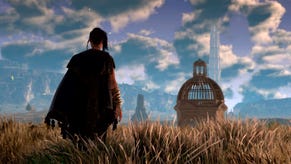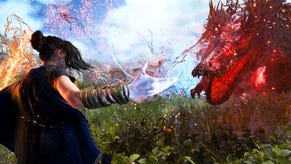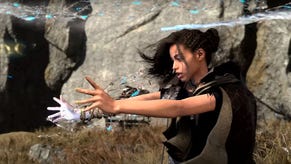Forspoken review: Already on borrowed time
It stumbles out the block with a slow, awkward opening and barely manages to recover its footing – even 10 hours later. But there's something in Forspoken, somewhere.
Forspoken shows the best and worst of the Luminous Engine’s tech, mixing kinetic combat with dazzling particle effects and janky set pieces.
Pressing the DualSense triggers in Forspoken is so hard I feel like I can now do finger push ups like Bruce Lee, but thankfully this doesn’t stop the combat from being one of the better parts of the experience – once you figure out how to play Bop-It with the complicated controls.
On your left hand, governed by L1 and L2, you have support spells designed for defensive zoning, stealing health from enemies, and buffing your abilities. While on your right you have your typical damage dealing spell types that you switch between with R1 and fire by pressing or holding R2.
There’s an impressive amount of different spells, especially as the story progresses, however, changing between them on the radial menu can be clunky and confusing because the constant switching between pressing and holding buttons feels like rubbing your tummy and patting your head at the same time.

Using the default control scheme, every time you want to move onto a new spell you need to hold either L1 or R1 to slow down time and bring up the menu. You then push the right stick – which moments earlier you were using to move the camera in a totally different direction – towards one of ten different, similar, symbols.
You then stop holding one button and press a different one to activate the ability, before pressing or holding another to start attacking again, while also pressing or holding to do different types of dodges. It feels like flicking a lightswitch on and off until it starts to fizzle.
The relatively long cooldown on support spells means you’re doing this over and over again during battle. Sometimes, once you’ve got the muscle-memory down for where everything is, it really flows and feels awesome to execute. That's when all the tiny moving parts are working as they should, though. Other times, you’re grinding through the gears like a novice driver on a track day.
Players bouncing off the control scheme feels like it'll be a particular issue for Forspoken, because the game’s opening likely does more to turn people away than hook them in – not an ideal sell for a premium, PS5 console-exclusive title.
.jpeg?width=690&quality=70&format=jpg&auto=webp)
The beginning of Forspoken is extremely unfortunate. You can plainly see the idea and intent behind the first chapter, but it seems like it just wouldn’t work technically, to the point where there are obvious holes and raw seams where it looks like whole sections were cut.
You play as Frey, a New York City “street kid” in her early 20s who’s struggling with the powerlessness of her unfair lot in life. And while I feel her characterisation as a petty criminal and juvenile delinquent is a bit gauche and stereotypical, she’s ably acted by Ella Balinska – who was in Netflix’s doomed Resident Evil show.
The events of a particularly terrible Christmas lead her to find a magical talking vambrace, nicknamed Cuff, and get transported to the medieval fantasy realm of Athia, complete with dragons, flying harpies and just the biggest apples I have ever seen.

Athia has been corrupted by the “Break”, a nebulous phenomenon that turned the land hostile and its inhabitants into monsters. To find her way home, Frey has to unravel the role of the four ruling Tantas – mages who symbolised the virtues of justice, love, wisdom and strength – in the arrival and origins of the Break. It’s good fiction, and there’s tomes' worth of interesting lore to uncover, so it’s a shame that it’s set up in such a faltering way. But what that does mean is there’s actually some depth and intrigue there (if you can push past the stumbles and lack of polish).
If (the excellent and underrated) Dragon’s Dogma was a Japanese publisher’s take on ideas popular in Western RPGs, then Forspoken is Square Enix’s answer to games like Assassin’s Creed – particularly in its approach to some story and side quests, called “Detours”. But a lot of these elements feel like they’re here for the sake of themselves, not because they’re good.
A lot of the time, you’re just trudging around pressing Triangle on an NPC to get to the next part without any stakes or interest.
One early side quest sees Frey feeding some sheep in the town meadow. You slowly walk up to the sheep. You press Triangle on the sheep. The screen fades to black and it says “you fed the sheep”. You do this FOUR TIMES.
Again, you can see the intent behind this kind of quieter world-building in contrast to the explosive action, but in context, this comes immediately after the bizarrely abrupt opening that already has your hackles up, and your first foray into the open world where you’re grappling to get to grips with the controls. It brings any momentum Forspoken was starting to build to a screeching halt. What's worse; it’s tough to bring yourself to skip side quests, because the changing world-state makes most detours limited time and therefore missable.
But once you’re let off the leash from this extended opening, however, going on protracted exploration sessions lets you dig into a better cadence of combat and collecting – even if the open world itself is a little strange.
.jpeg?width=690&quality=70&format=jpg&auto=webp)
To get around, Frey uses magical parkour by holding Circle, which sees her zip across the world leaving a golden trail in her wake.
Rather than being level gated, Forspoken’s landscape is broken up – almost Metroidvania-style – by areas that are inaccessible before you get certain movement abilities. Yet again, this makes it frustrating to navigate at first because you don’t know why you can’t climb up things you can see points of interest on top of, but flows much better once the full kit is available.
The lack of polish is still there, though. By default, Cuff and Frey incessantly say the same voice lines to each other over and over again. But gathering new stat-boosting cloaks and necklaces from combat challenges, as well as new nail art sets which give unique spell-casting buffs, gives you tangible rewards (unlike the side quests), and let you enjoy the flashy battling almost uninterrupted.
In the cut-throat race for your attention, Forspoken feels like a new IP that’s trying to run full pelt alongside heavy-hitting franchises from other big publishers. But it ploughs, shin-first, through every hurdle along the way. Its stuttering start belies a combat system that’s worth investing the effort to learn, but takes so long to get up to full speed that it’s already on borrowed time.
Reviewed on PS5, code provided by publisher.









